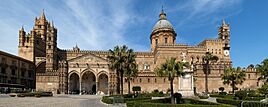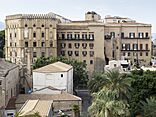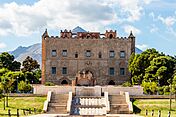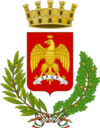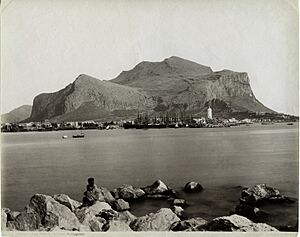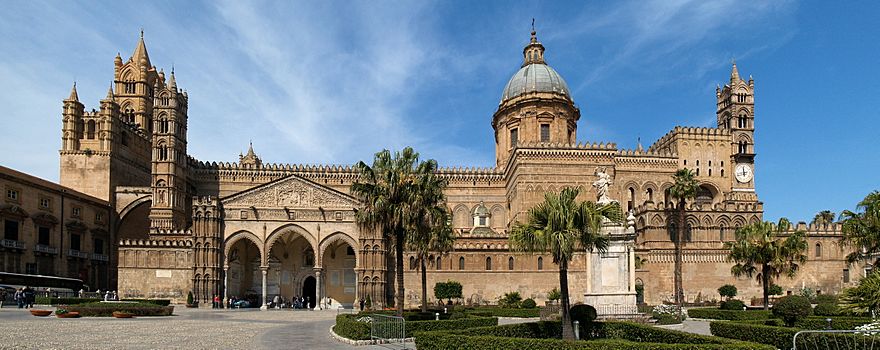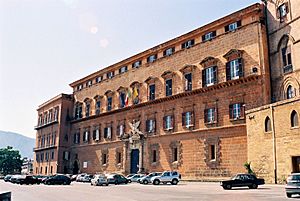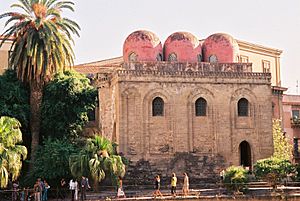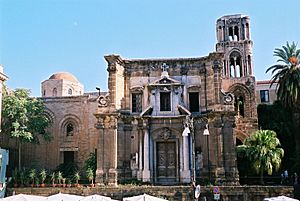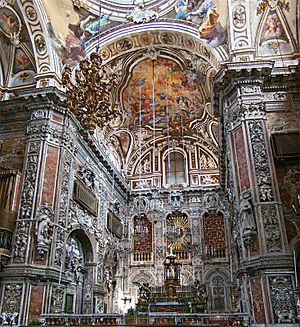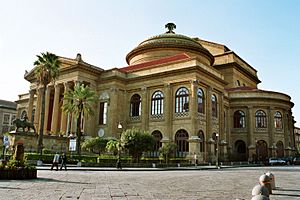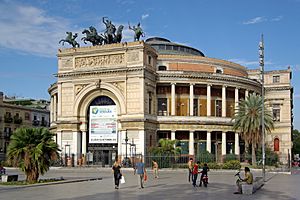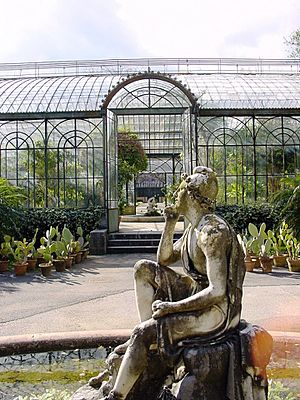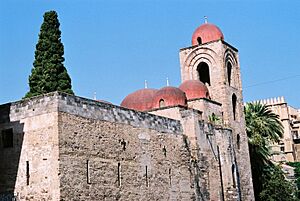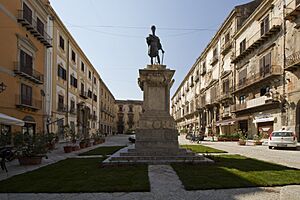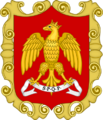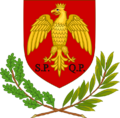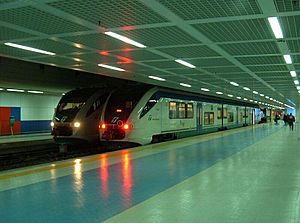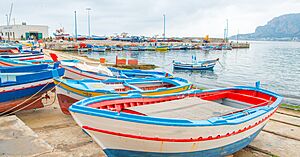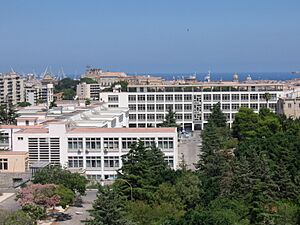Palermo facts for kids
Quick facts for kids
Palermo
Palermu (Sicilian)
|
|||
|---|---|---|---|
| Comune di Palermo | |||
|
Palermo Cathedral
Interior of Santa Caterina Church
Norman Palace
Piazza Pretoria
San Giuseppe dei Teatini
the Virgin Annunciate in the Palazzo Abatellis
Zisa
|
|||
|
|||
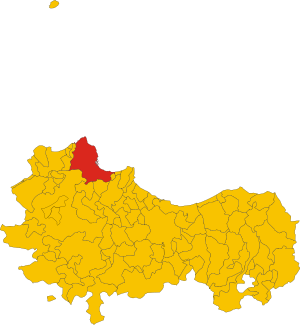
The municipality of Palermo within the
Metropolitan City of Palermo |
|||
| Country | Italy | ||
| Region | Sicily | ||
| Founded | 736 BC | ||
| Area | |||
| • Total | 158.9 km2 (61.4 sq mi) | ||
| Elevation | 14 m (46 ft) | ||
| Population
(31 January 2013)
|
|||
| • Total | 676,118 (city) 1,300,000 (metro) |
||
| Demonym(s) | Palermitano Panormito Palermitan (English) |
||
| Time zone | UTC+1 (CET) | ||
| • Summer (DST) | UTC+2 (CEST) | ||
| Postal code |
90100
|
||
| Dialing code | 091 | ||
| Patron saint | Saint Rosalia, Saint Agata, Saint Oliva and Saint Benedict the Moor | ||
| Saint day | 14 July | ||
Palermo is a historic city in southern Italy. It is the capital of the autonomous region of Sicily and the Metropolitan City of Palermo. The city is famous for its long history, unique culture, amazing buildings, and delicious food. Palermo is over 2,700 years old. It is located on the northwest side of Sicily, by the Gulf of Palermo in the Tyrrhenian Sea.
The city was founded in 734 BC by the Phoenicians. They called it Ziz, meaning "flower." Later, it became part of Carthage. The ancient Greeks called it Pánormos, meaning "wide haven," because of its large port. This name is where "Palermo" comes from today. After the Greeks, Palermo was part of the Roman Republic and Roman Empire for over a thousand years. From 831 to 1072, the city was under Arab rule. It became the capital of Sicily for the first time and was known as Balarm.
After the Normans took over, Palermo became the capital of the new Kingdom of Sicily. This kingdom lasted from 1130 to 1816. Today, Palermo is Sicily's main cultural, economic, and tourism center. Many visitors come to enjoy its warm Mediterranean climate, famous food, and beautiful Romanesque, Gothic, Baroque, and Art Nouveau buildings.
Palermo is also a major industrial and commercial hub in Sicily. Its main industries include tourism, services, trade, and farming. The city has an international airport and a busy port. Palermo is one of the biggest cities in the Mediterranean region. It is a top tourist spot in Italy and Europe. It is home to the UNESCO World Heritage Site called Arab-Norman Palermo and the Cathedral Churches of Cefalù and Monreale.
Roman Catholicism is very important in Palermo's culture. The main patron saint of Palermo is Saint Rosalia. Her feast day is celebrated on July 15th. The city is also known for its colorful fruit, vegetable, and fish markets. These include Vucciria, Ballarò, and Capo.
Contents
Exploring Palermo's Geography
Palermo sits in a valley called the Conca d'Oro, or "Golden Basin." This basin was formed by the Papireto, Kemonia, and Oreto rivers. The Arabs gave it its name in the 9th century. Mountains surround the city, facing the Tyrrhenian Sea. Palermo has a natural port and offers great views of the sea, especially from Monte Pellegrino.
Palermo's Climate
Palermo has a warm Mediterranean climate. Summers are long, hot, and dry. Winters are mild and rainy. Spring and autumn are usually warm. Palermo is one of the warmest cities in Europe. Its average yearly temperature is about 18°C (64°F). The city gets around 2,530 hours of sunshine each year. Snow is very rare in Palermo. It has snowed only about a dozen times since 1945. The lowest temperature ever recorded was -2.5°C (27.5°F) in February 1967. The average sea temperature is above 19°C (66°F). It ranges from 14°C (57°F) in February to 26°C (79°F) in August.
Mountains and Rivers of Palermo
Palermo is surrounded by mountains that form a circle around the city. These mountains divide some parts of the city. Historically, it was hard to reach the inner part of Sicily from Palermo because of these mountains. The tallest peak is La Pizzuta, which is about 1,333 meters (4,373 feet) high.
The most important mountain is Monte Pellegrino. It stands apart from the other mountains, right in front of the Tyrrhenian Sea. A famous writer, Johann Wolfgang von Goethe, called Monte Pellegrino "the most beautiful promontory in the world."
Today, the Papireto and Kemonia rivers are covered by buildings. However, you can still see where they used to flow because the streets built on top of them follow their old paths. The only river that still flows freely is the Oreto river. It separates the city center from the western and industrial areas.
City Districts
Palermo is divided into 35 neighborhoods, also known as "quartiere." These neighborhoods are grouped into eight government community boards. Here are the main municipalities and their quarters:
| Municipality | Quarters |
|---|---|
| I | Kalsa, Albergheria, Seralcadio & La Loggia |
| II | Settecannoli, Brancaccio & Ciaculli-Oreto |
| III | Villagrazia-Falsomiele & Stazione-Oreto |
| IV | Montegrappa, S. Rosalia, Cuba, Calafatimi, Mezzomonreale, Villa Tasca-Altarello & Boccadifalco |
| V | Zisa, Noce, Uditore-Passo di Rigano & Borgo Nuovo |
| VI | Cruillas, S. Giovanni Apostolo, Resuttana & San Lorenzo |
| VII | Pallavicino, Tommaso Natale, Sferracavallo, Partanna Mondello, Arenella, Vergine Maria & San Filippo Neri (formerly known as ZEN) |
| VIII | Politeama, Malaspina-Palagonia, Libertà & Monte Pellegrino |
Famous Landmarks and Buildings
Palermo has many amazing old buildings, especially those built in the Norman style.
Palaces and Museums
- Palazzo dei Normanni (the Norman Palace): This is a great example of Norman architecture. It houses the famous Cappella Palatina.
- Zisa (1160) and Cuba: These were grand castles or houses. Kings of Palermo used them for hunting. Today, the Zisa houses an Islamic museum. The Cuba was once surrounded by water.
- Palazzo Abatellis: Built in the late 1400s, this elegant building shows Catalan Gothic style with Renaissance touches. It has a gallery with important artworks.
- Antonino Salinas Regional Archeological Museum: This museum displays many ancient items. You can see things from Etruscan, Carthaginian, Roman, and Hellenistic times. It also has decorations from Sicilian temples.
- Palazzina Cinese: This was a royal home for the House of Bourbon-Two Sicilies. It now holds the Ethnographic Museum of Sicily.
Churches of Palermo
- Palermo Cathedral: This cathedral has a very long history. It shows many different building styles, with the latest changes made in the 18th century.
- Cappella Palatina: This 12th-century chapel is inside the Norman Palace. It has amazing mosaics that mix Western and Eastern art. Its roof was built by Saracen craftsmen.
- San Giovanni degli Eremiti: This 12th-century church is famous for its bright red domes. These domes show the influence of Arab design in Sicily.
- Chiesa della Martorana: Also called Santa Maria dell'Ammiraglio, this church is known for its beautiful Byzantine mosaics. Its bell tower is also a main entrance.
- San Cataldo: Located in Piazza Bellini, this church is another example of Norman architecture.
- Santa Caterina: Built between 1566 and 1596, this church is located near Piazza Pretoria.
- San Giuseppe dei Teatini: Found near the Quattro Canti, this church is a great example of Sicilian Baroque style.
- Oratorio di San Lorenzo: This church is famous for its incredible stucco decorations. The artist Giacomo Serpotta and his family filled the walls with statues and angels.
Squares and Public Monuments
- Quattro Canti: This small square is where two main ancient roads cross. The buildings on the corners have curved baroque fronts, making the square look almost octagonal.
- Piazza Pretoria: This square was designed in the 16th century. It features a large and beautiful fountain called the Fontana Pretoria.
- The monument to Charles V: This statue was put up in 1631 in Piazza Bologni. It remembers the monarch's visit to Palermo in 1535.
City Walls

Palermo once had two sets of city walls, and many parts of them still exist today. The first wall surrounded the very old Phoenician city. This early city was protected by the Kemonia and Papireto rivers, which acted like a natural moat. During Roman times, these walls were made even stronger.
Later, in the Middle Ages, the city grew, and a second wall was built. The main road, Via Vittorio Emanuele, still ran through the walled city. Several gates from these city walls can still be seen today.
Opera Houses
- The Teatro Massimo ("Greatest Theatre"): This opera house opened in 1897. It is the biggest in Italy and one of the largest in Europe. It is known for its perfect sound quality. After being closed for renovation, it reopened in 1997 and now has many shows.
- The Teatro Politeama: This theater was built between 1867 and 1874.
Other Interesting Sights
The "Wall of Legality" is a street art project in Piazza degli Aragonesi. It shows 38 important people who fought against the mafia. Nineteen artists worked together on this project, which opened in July 2022.
The Palermo Cathedral has a heliometer from 1690. This device uses a small hole to project an image of the sun onto the floor at noon. A bronze line on the floor, called la Meridiana, runs north-south. It shows the sun's position at different times of the year. This tool helped people keep time and set the calendar correctly.
The Orto botanico di Palermo (Palermo Botanical Garden) was founded in 1785. It is the largest botanical garden in Italy, covering 10 hectares (25 acres).
Another unique place is the Capuchin Catacombs. Here, you can see many mummified bodies in different states of preservation.
Near the city is Monte Pellegrino, which is about 600 meters (2,000 feet) high. It offers amazing views of the city, the mountains, and the sea.
The Ficus macrophylla tree on Piazza Marina is very impressive. It has a trunk over 30 meters (98 feet) around and is 32 meters (105 feet) tall. It is likely the thickest tree in Europe.
UNESCO World Heritage Sites
Palermo is home to several UNESCO World Heritage Sites. These include the Palazzo Reale with the Cappella Palatina, the Chiesa di San Giovanni degli Eremiti, the Chiesa di Santa Maria dell’Ammiraglio, the Chiesa di San Cataldo, the Cattedrale di Palermo, the Palazzo della Zisa, and the Ponte dell’Ammiraglio. These sites help make Italy the country with the most UNESCO World Heritage sites.
People and Population
In 2010, about 1.2 million people lived in the greater Palermo area. Around 655,875 of them lived within the city limits. The population of Palermo decreased by 4.5% between 2001 and 2010. This is because many people moved to the suburbs or to Northern Italy.
Most of Palermo's population (97.79%) is of Italian descent. The largest groups of immigrants come from South Asia (like Bangladesh and Sri Lanka), other European countries (like Albania and Romania), and North Africa (like Tunisia and Morocco).
| Country of birth | Population |
|---|---|
| 5,296 | |
| 3,394 | |
| 3,171 | |
| 2,544 | |
| 1,738 | |
| 1,048 | |
| 1,014 | |
| 973 | |
| 856 | |
| 588 | |
| other countries | each <588 |
A Look at Palermo's History
Early Settlements
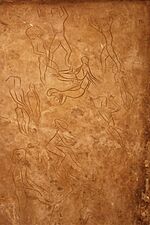
People have lived in the Palermo area since at least 8000 BC. Cave drawings from this time have been found nearby at Addaura. The first known inhabitants were the Sicani people. They are believed to have come from the Iberian Peninsula.
In the 8th century BC, the Phoenicians built a small settlement on Palermo's natural harbor. They called it Ziz. It became one of the three main Phoenician colonies in Sicily. This first settlement was later known as Paleapolis, meaning "Old City."
A "New City" called Neapolis soon grew next to the old one. This new area quickly became a center for markets and trade. Walls were built around the expanded city. The walls followed the two rivers, the Kemonia and Papireto, creating a natural defense. The main street of the colony was the Corso Vittorio Emanuele.
Ancient Times
Carthage was Palermo's main trading partner during the Phoenician period. The city enjoyed a long time of peace. Between the 6th and 5th centuries BC, Palermo came into contact with the Ancient Greeks. This led to the Sicilian Wars, where Greeks from Syracuse fought the Carthaginians for control of Sicily. During this time, the Greeks named the settlement Pánormos.
In 276 BC, Palermo briefly became a Greek colony. But it returned to Carthage in 275 BC. In 254 BC, the Romans took over Panormos. Carthage tried to get it back in 250 BC but failed. During Roman times, many fancy homes were built in the city.
The Middle Ages
As the Roman Empire began to fall, different Germanic tribes took control of Palermo. First were the Vandals in 440 AD. They were followed by the Ostrogoths in 488 AD. In 535 AD, the Byzantine Empire conquered Palermo after a siege.
The Arabs took control of Palermo and most of Sicily in 831 AD. They established the Emirate of Sicily. Palermo, called Bal'harm by the Arabs, became the capital of Sicily. It grew into a very important and grand city. The Arabs also brought many new crops to Sicily, which are still important in Sicilian cuisine today.
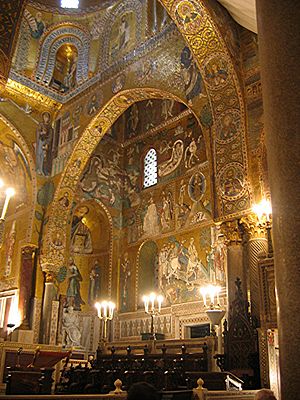
After some disagreements among the Arab rulers, the Normans conquered Palermo in 1072. This was a difficult task because Palermo was a large city with strong walls. After a five-month siege, the Normans finally took the city. The Hautevilles brought Christianity back to the city.
Under Roger II of Sicily, the Norman lands in Sicily became the Kingdom of Sicily. Palermo was the capital of this new kingdom. Many buildings, like the Palermo Cathedral, were built during this time. The Kingdom of Sicily became one of the richest states in Europe.
Later, Palermo and Sicily were inherited by Frederick II, Holy Roman Emperor. He became King of Sicily in 1198. Palermo was his favorite city and the capital of his large empire. After a period of French rule, Sicily came under the control of the Aragon and Barcelona families. By 1330, Palermo's population had dropped to 51,000.
Early Modern Times
From 1479 to 1713, Palermo was ruled by the Kingdom of Spain. It was also under Savoy control for a few years and then by Austria.
The Kingdom of the Two Sicilies
After 1734, Palermo became part of the Bourbon lands. Charles III was crowned King of Sicily in Palermo. New houses were built, and trade grew. However, Palermo became less important as the Royal Court moved to Naples.
From 1820 to 1848, Sicily saw many changes. On January 12, 1848, a popular uprising began in Palermo. It was the first revolution in Europe that year. A new government and constitution were created. But the Bourbons took Palermo back in 1849. The city remained under their rule until 1860. In May 1860, Giuseppe Garibaldi and his army conquered the city. After a vote, Palermo and the rest of Sicily became part of the new Kingdom of Italy in 1861.
Italian Unification and Modern Era

After Italy was unified, Palermo experienced a new period of growth. New boulevards like Via Roma and Viale della Libertà were built. Many beautiful villas in the Art Nouveau style were constructed along these roads. The large Teatro Massimo opera house was also built during this time.
During the Second World War, Palermo was heavily bombed by Allied forces in 1942 and 1943. The harbor and many parts of the city were destroyed. When American troops entered Palermo in 1943, they were warmly welcomed by the people.
In 1946, Palermo became the seat of the Regional Parliament. This made it the capital of a special region. A major challenge for the city in modern times has been dealing with organized crime. In the mid-20th century, many historic buildings were destroyed to make way for new, often poorly built, structures. This period is known as the "Sack of Palermo."
Culture and Traditions
Religion and Patron Saints
Saint Rosalia is the main patron saint of Palermo. She is greatly admired. On July 14th, Palermo celebrates the annual Festino. This is a big procession that honors Saint Rosalia. People believe she saved the city from the Black Death in 1624. Her remains were found in a cave on Monte Pellegrino. When her remains were carried around the city, the plague disappeared. There is a special place of worship where her remains were found.
Before 1624, Palermo had four patron saints: Saint Agatha, Saint Christina, Saint Nympha, and Saint Olivia.
Saint Lucy is also honored on December 13th. On this day, people in Palermo do not eat anything made with flour. Instead, they boil wheat and use it to make a special dish called cuccìa. This tradition remembers how Saint Lucy saved the city from hunger. A ship full of grain mysteriously arrived in the harbor, and the hungry people ate the grain as it was.
The ancient protector of the city was the Genius of Palermo. This spirit became the modern city's secular patron.
Sports in Palermo
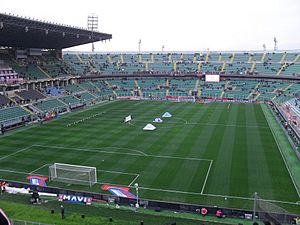
Palermo has a professional football team called Palermo Football Club. They currently play in Serie B.
The Targa Florio was a famous car race held near Palermo. It was one of the oldest sports car racing events. It stopped being a race in 1977 due to safety concerns. Now, it is a rallying event. Palermo was also the starting point for the 2008 Giro d'Italia bicycle race.
The Internazionali Femminili di Palermo is an annual professional tennis event for women. It is part of the WTA Tour.
City Symbols
Flag
The flag of Palermo looks similar to Sicily's regional flag. However, the colors are arranged differently. The flag at the town hall does not have a coat of arms. But some versions of the flag do have a coat of arms in the center.
Coat of Arms
The coat of arms has a red shield with a golden eagle in the middle. The eagle has its wings open and holds a banner with the letters "S.P.Q.P." It is topped with the city's crown.
Economy and Transportation
As Sicily's capital, Palermo is a major center for money, tourism, and trade. The city has an international airport. Palermo's economy mainly relies on tourism and services. Other important areas include trade, shipbuilding, and farming.
Public Transportation
Palermo has a local railway system called the Palermo metropolitan railway service.
The city's public bus system is run by AMAT. It covers a large area with about 90 different routes. These routes reach every part of the city.
Palermo also has a public tram system, which was completed in 2015. It is also operated by AMAT and has four lines.
The local coach company, AST, connects Palermo to all the main cities in Sicily.
On average, people in Palermo spend about 63 minutes using public transit on a weekday. About 14% of riders travel for more than two hours each day. The average wait time at a stop is 23 minutes. The average distance for a single trip is 4.4 kilometers (2.7 miles).
Roads and Airports
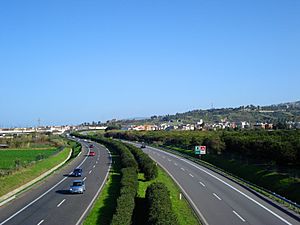
Palermo is a key point in Sicily's road network. It connects to major motorways that lead to other cities like Trapani, Catania, and Messina. Palermo is also on European route E90.
Palermo International Airport, also known as Falcone-Borsellino Airport, is located 32 kilometers (20 miles) west of the city. It is named after two anti-mafia judges, Giovanni Falcone and Paolo Borsellino. The airport has a train station that connects to Palermo's main railway stations.
Palermo-Boccadifalco Airport is the city's second airport.
Port of Palermo
The port of Palermo was founded by the Phoenicians over 2,700 years ago. It is one of Sicily's main ports. From here, ferries connect Palermo to cities like Cagliari, Genoa, Naples, and Tunis. The port handles almost 2 million passengers each year. It is also an important stop for cruise ships. The port also connects to smaller Sicilian islands. There is a special area in the port for sailing yachts.
National Rail
The main railway station in Palermo is Palermo Centrale. It connects Palermo to other cities in Sicily, such as Agrigento, Trapani, and Catania. Through Messina, it connects to the rest of Italy. Trains also run from here to the Palermo airport every thirty minutes.
Education
The main university in Palermo is the University of Palermo. It is the second oldest university on the island. It was officially founded in 1806. However, people have been studying medicine and law there since the late 15th century. The Orto botanico di Palermo (Palermo Botanical Garden) is part of the university.
International Connections
Sister Cities
Palermo is twinned with many cities around the world. This means they have special friendly relationships.
 Bizerte, Tunisia
Bizerte, Tunisia Bukavu, DR of the Congo
Bukavu, DR of the Congo Chengdu, China
Chengdu, China Düsseldorf, Germany
Düsseldorf, Germany Grand-Bassam, Ivory Coast
Grand-Bassam, Ivory Coast Hanoi, Vietnam
Hanoi, Vietnam Khan Yunis, Palestine
Khan Yunis, Palestine Miami, United States
Miami, United States Monterey, United States
Monterey, United States Montpellier, France
Montpellier, France Ottawa, Canada
Ottawa, Canada Palermo, Argentina
Palermo, Argentina Palermo, Colombia
Palermo, Colombia Pistoia, Italy
Pistoia, Italy Samara, Russia
Samara, Russia Santiago de Cuba, Cuba
Santiago de Cuba, Cuba Sestu, Italy
Sestu, Italy Tbilisi, Georgia
Tbilisi, Georgia Timișoara, Romania
Timișoara, Romania Valletta, Malta
Valletta, Malta Yaroslavl, Russia
Yaroslavl, Russia Sekondi-Takoradi, Ghana
Sekondi-Takoradi, Ghana
Famous People from Palermo
Many notable people were born in Palermo or have strong ties to the city. Here are just a few:
- Eleonora Abbagnato (born 1978), a ballet dancer
- Mario Balotelli (born 1990), a famous footballer
- Ernesto Basile (1857–1932), a well-known architect
- Letizia Battaglia (1935–2022), a photographer and politician
- Paolo Borsellino (1940–1992), a respected judge
- Alessandro Cagliostro (1743–1795), a famous adventurer
- Stanislao Cannizzaro (1826–1910), a chemist
- Giovanni Falcone (1939–1992), another respected judge
- Vincenzo Florio (1883–1959), a successful entrepreneur
- Sergio Mattarella (born 1941), the current president of Italy
- Giuseppe Pitrè (1841-1916), a folklorist and doctor
- Pope Sergius I (650-701)
- Alessandro Scarlatti (1660-1725), a composer
- Giacomo Serpotta (1656–1732), a famous sculptor
- Giuseppe Tomasi di Lampedusa (1896–1957), a writer
Honorary Citizens
Some people have been given the honorary citizenship of Palermo. This is a special honor.
| Date | Name | Notes |
|---|---|---|
| 17 May 1996 | Tenzin Gyatso | The 14th Dalai Lama |
| 14 December 2015 | Abdullah Öcalan | Founder of Kurdistan Workers' Party |
| 21 August 2018 | Albert II, Prince of Monaco | Prince of Monaco |
Images for kids
See also
 In Spanish: Palermo para niños
In Spanish: Palermo para niños


